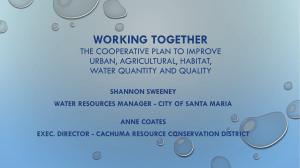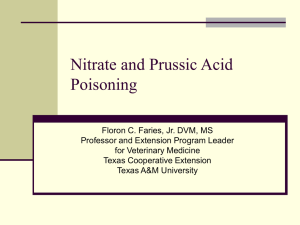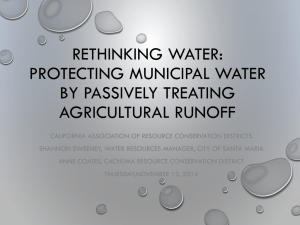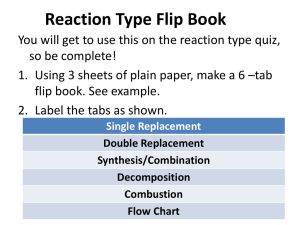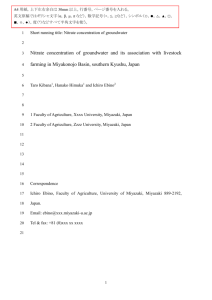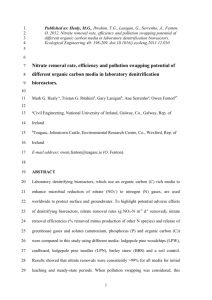Bioremediation_Teacher - CSIP Cornell
advertisement
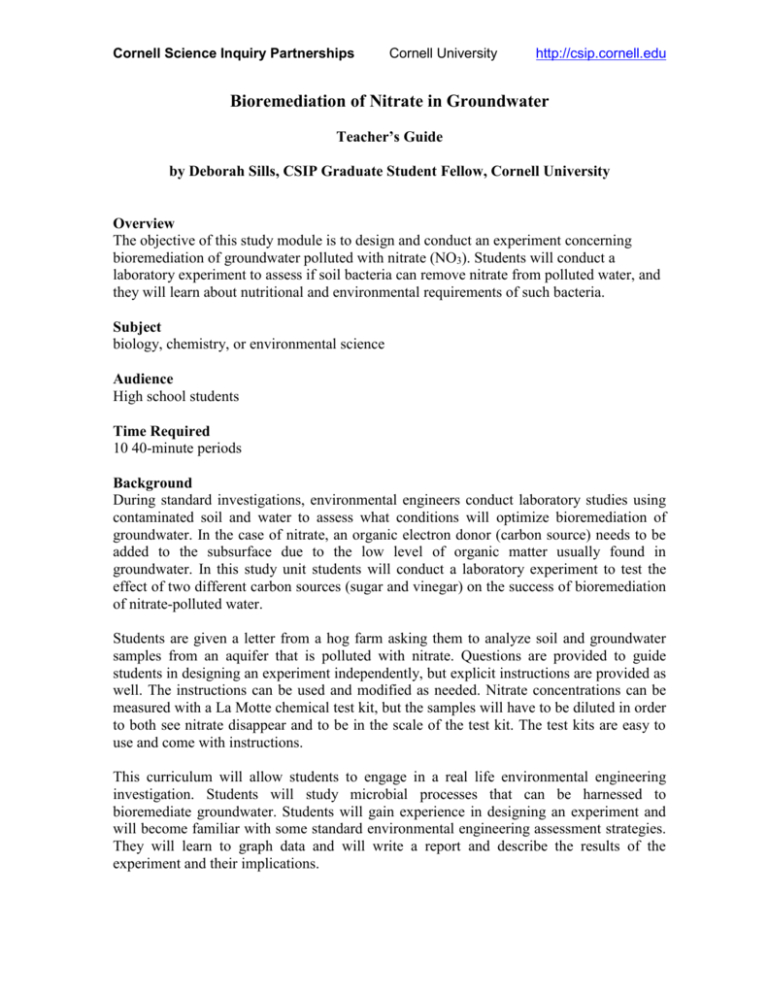
Cornell Science Inquiry Partnerships Cornell University http://csip.cornell.edu Bioremediation of Nitrate in Groundwater Teacher’s Guide by Deborah Sills, CSIP Graduate Student Fellow, Cornell University Overview The objective of this study module is to design and conduct an experiment concerning bioremediation of groundwater polluted with nitrate (NO3). Students will conduct a laboratory experiment to assess if soil bacteria can remove nitrate from polluted water, and they will learn about nutritional and environmental requirements of such bacteria. Subject biology, chemistry, or environmental science Audience High school students Time Required 10 40-minute periods Background During standard investigations, environmental engineers conduct laboratory studies using contaminated soil and water to assess what conditions will optimize bioremediation of groundwater. In the case of nitrate, an organic electron donor (carbon source) needs to be added to the subsurface due to the low level of organic matter usually found in groundwater. In this study unit students will conduct a laboratory experiment to test the effect of two different carbon sources (sugar and vinegar) on the success of bioremediation of nitrate-polluted water. Students are given a letter from a hog farm asking them to analyze soil and groundwater samples from an aquifer that is polluted with nitrate. Questions are provided to guide students in designing an experiment independently, but explicit instructions are provided as well. The instructions can be used and modified as needed. Nitrate concentrations can be measured with a La Motte chemical test kit, but the samples will have to be diluted in order to both see nitrate disappear and to be in the scale of the test kit. The test kits are easy to use and come with instructions. This curriculum will allow students to engage in a real life environmental engineering investigation. Students will study microbial processes that can be harnessed to bioremediate groundwater. Students will gain experience in designing an experiment and will become familiar with some standard environmental engineering assessment strategies. They will learn to graph data and will write a report and describe the results of the experiment and their implications. Learning and Behavioral Objectives Students will: learn about nitrate, its sources, and problems associate with nitrate-contaminated water learn to generate a hypothesis and design an experiment to test the effect of two carbon sources on biological nitrate reduction learn to dilute a sample and test the sample for nitrate with a La Motte chemical test kit measure dissolved oxygen, pH, and nitrate graph data write a report that will explain and summarize the results of the experiment National Science Education Standards, Grades 9-12 Science as Inquiry Identify questions and concepts that guide scientific investigations. Design and conduct scientific investigations Physical Science Chemical reactions Interactions of energy and matter Life Science Interdependence of organisms Matter, energy, and organization of living systems (ecosystem level) Science in personal and social and perspectives Personal and community health Environmental quality Assessment Strategy In the pilot classes assessment was based on student participation, a written report, and posters that students prepared. Students were required to present their results (graphs) and explain them. Teaching Tips and Additional Background Information Motivation This curriculum was designed in response to a request made by teachers at Whitney Point High School to conduct a hands-on activity that would address bioremediation of chlorinated solvents. Whitney Point is located near an area polluted by an IBM spill of trichloroethylene (TCE) in Endicott, New York. Chlorinated solvents pose risks to human health and so it was not possible to study bacteria that degrade these compounds with high school students. This experiment was designed to show students a biological process that mimics biodegradation of chlorinated solvents such as tetrachloroethylene (PCE), and TCE, which are common groundwater contaminants throughout the US. Nitrate (unlike chlorinated solvents) is not dangerous for students to work with and it is easy to monitor with chemical test kits. This curriculum was piloted in Whitney Point High School and Newark Valley High School. Students read newspaper articles and conducted Internet research to learn about local chlorinated solvent pollution problems before conducting the laboratory experiment. 2 Preparation of Nitrate Polluted Water Before students prepare the microcosms the teacher will need to prepare 2 liters of nitrate polluted water. To prepare the polluted water, add 1.2 grams of sodium nitrate (NaNO3) to 2 L of water to obtain approximately 100 ppm NO3-N. 100 ppm together with enough carbon source (e.g. sugar) should allow adequate growth of pseudomonas and subsequent nitrate removal. Additional Information on Denitrification and Biochemistry Directions are provided to students on how much sugar or vinegar to add to their microcosm bottles. In the pilot classes, information was not provided to students on how the amounts of sugar and vinegar were determined. In more advanced classes teachers may wish to present information about the biochemistry of the denitrification process. Pseudomonas bacteria transform nitrate into nitrogen gas as part of their metabolism. These bacteria use a carbon source (e.g. sugar) and nitrate both for energy and to build new cells. This means that some of the carbon in sugar and nitrogen in nitrate is incorporated into bacterial cells and some of the carbon and nitrogen is used for the bacteria to obtain energy. Bacteria obtain energy by breaking chemical bonds and forming new ones by “moving around” electrons. During denitrification, pseudomonas use sugar as an electron donor and nitrate as an electron acceptor. (Humans obtain energy in a similar way and use sugars as an electron donor and oxygen as an electron acceptor). Following are the unbalanced equations that describe the energy and cell formation processes that occur during biological denitrification. C6H12O6 + H2O CO2 + H+ + eNO3 + H+ + e- N2 + H2O NO3 + CO2 + H+ + e- C5H7O2N + H2O Additional equations that are beyond the scope of this curriculum and stoichiometry were used to calculate the amounts of sugar and vinegar that need to be used in the experiment, which are provided to students in the experimental procedure directions. Additional Information on Using the La Motte test kit In the pilot classes we used a La Motte nitrate test kit NCR 2 Code- 3519. The range of the test kit is 0-10 ppm NO3-N. The experiment in this curriculum uses water with 100 ppm NO3-N, and so in order to use the test kit, students will have to dilute their water samples. The kit requires a 5 mL sample. The dilution can be conducted by mixing 0.5 mL of sample with 4.5 mL of distilled water. This material was developed through the Cornell Science Inquiry Partnership program (http://csip.cornell.edu), with support from the National Science Foundation’s Graduate Teaching Fellows in K-12 Education (GK-12) program (DGE # 0231913 and # 9979516) and Cornell University. Any opinions, findings, and conclusions or recommendations expressed in this material are those of the author(s) and do not necessarily reflect the views of the NSF. 3

